Learn how to make homemade sourdough puff pastry that can be used for anything from turnovers to pies. This easy recipes makes the most delicious, flaky, and buttery pastries.

This is the same dough I’ve used to make other pastries you can find here on the blog, but I wanted a place for just the puff pastry recipe.
A place to go when you find any recipe calling for store-bought puff pastry, but you want to make a healthier, fermented version from scratch.
So you can create family classics that a lot of us grew up eating (cough cough, pigs in a blanket), but with this homemade version instead. Grass-fed hot dogs wrapped in this classic puff pastry sounds pretty delicious if you ask me.
I love this recipe so much because it can be used in so many ways. From danish pastries to homemade pie crust, from sweet applications to savory fillings. It is an all around very versatile and a pretty easy recipe once you get the hang of it.

Tips
- Be careful to not let the dough or the butter get too warm during lamination. You want to work fairly quickly ensuring both stay around the same temperature. Rather than creating butter layers, the butter will just melt into the dough. If either the dough or the butter does get too warm, stick it in the fridge for 10-30 minutes and then continue working on the dough.
- This recipe uses natural yeast rather than commercial yeast to give rise to the dough.
- Make sure to check out how to make a sourdough starter here if you are just getting started with sourdough.
This post contains affiliate links, which means I make a small commission at no extra cost to you. See my full disclosure here.
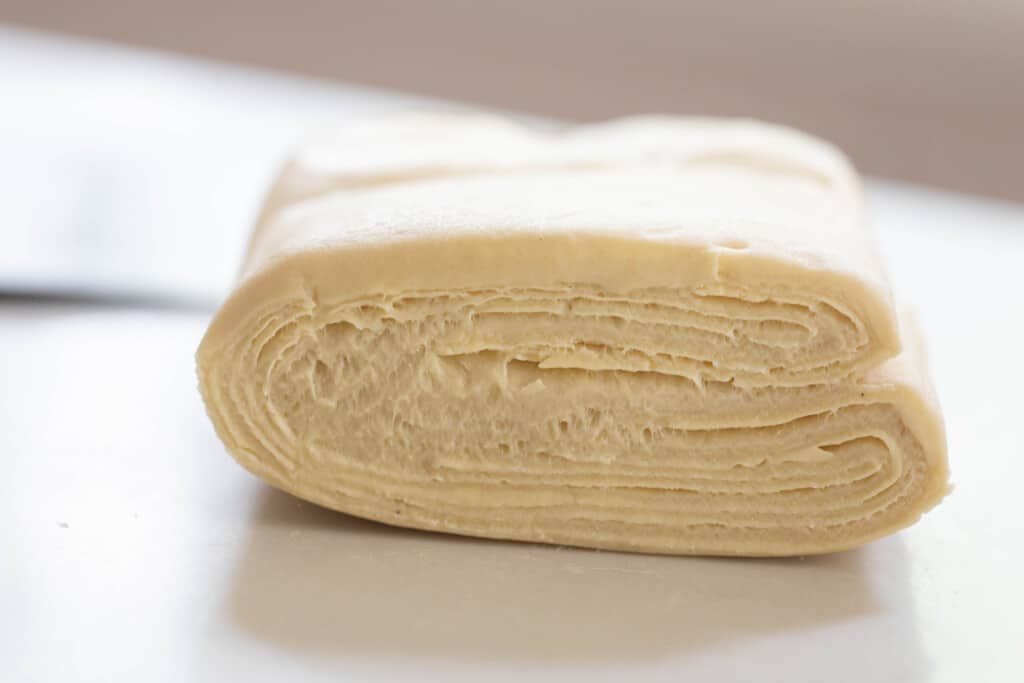
FAQ:
Some butter leakage during baking is normal. But if there is a lot of leaking something may have gone wrong during the lamination. The butter and dough may have gotten too soft making them combine together rather than creating flaking layers.
I recommend placing an empty baking sheet under the baking sheet with puff pastry during baking. This will catch any butter that leaks out and prevents it from hitting the bottom of the oven causing potential issues.
They are almost identical except that croissant dough is a bit drier, whereas pastry dough is more of an enriched dough (like brioche) that is moister and includes eggs.

Dough Ingredients:
- All purpose flour
- Sugar
- Active sourdough starter, bubbly and active. You can not use sourdough starter discard for this, recipe unfortunately
- Whole milk
- Egg
- Vanilla extract
- Salt
Butter for laminating
- Unsalted butter: Cold. Make sure to use real butter. The fake stuff won’t work. The layers of butter will create the most flaky pastry.
- All purpose flour
Egg wash:
- Egg white
- Water

Filling ideas:
- Fruit: Fresh, canned or frozen fruit. If using canned fruit, make sure to drain any excess liquid. For frozen fruit, use from frozen, don’t let it thaw.
- Lemon curd
- Pie filling – This could be sweet pies like apple, cherry, blueberry etc. Or savory pies like chicken pot pie (swap out the biscuits), shepherd’s pie (add it to the top), quiche, etc.
- Jam
- Cream cheese
- Nutella
- Sausage
- Ground beef
- Chocolate
Tools you may need:
Stand mixer with dough hook attachment
Rolling Pin
Baking sheet – I like these stainless steel baking sheets
Parchment paper
Large mixing bowl
Bench scraper

How To Make Sourdough Pastry: Step-By-Step Instructions
To a bowl of a stand mixer with a dough hook attachment, add the dry ingredients, sourdough starter, milk, egg, and vanilla.
Mix on low speed (1 or 2) for about 5 or so minutes or until it becomes smooth and glossy. This ensures adequate gluten formation has occurred. You can also knead this by hand. Mix and knead to make a shaggy, sticky dough then continue to knead for about 5-10 minutes until smooth and glossy.
Shape into a ball and place in a greased large bowl. Cover with plastic wrap, foil, or a beeswax wrap and place at room temperature (a warm place) for about 4 hours.
Transfer the bowl to the refrigerator to continue fermenting for 8 hours, or up to 3 days.
Laminating the dough
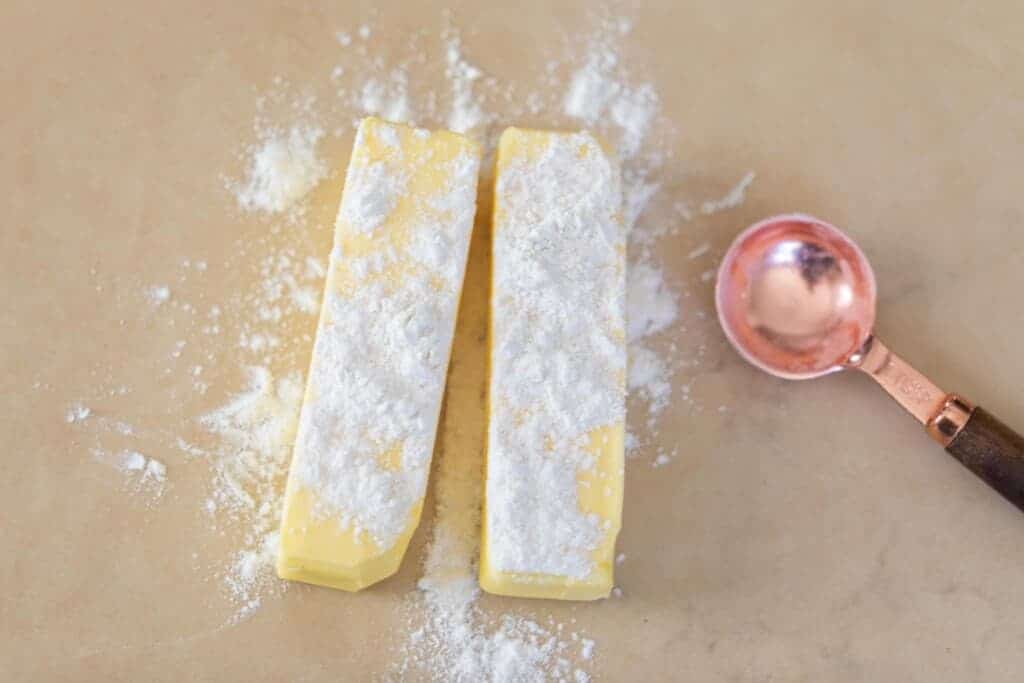
Place the sticks of butter on a large piece of parchment paper. Sprinkle it with a little flour. Mark a 6″ by 8″ rectangle onto the parchment paper.
Fold the parchment paper around the butter with the folds on that 6″ by 8″ rectangle you made, so that the butter will fill the entire envelope once you roll it out (also called a butter packet). It doesn’t need to be perfectly precise. You just want to make sure the pastry dough can enclose the butter when you roll it out for laminating.
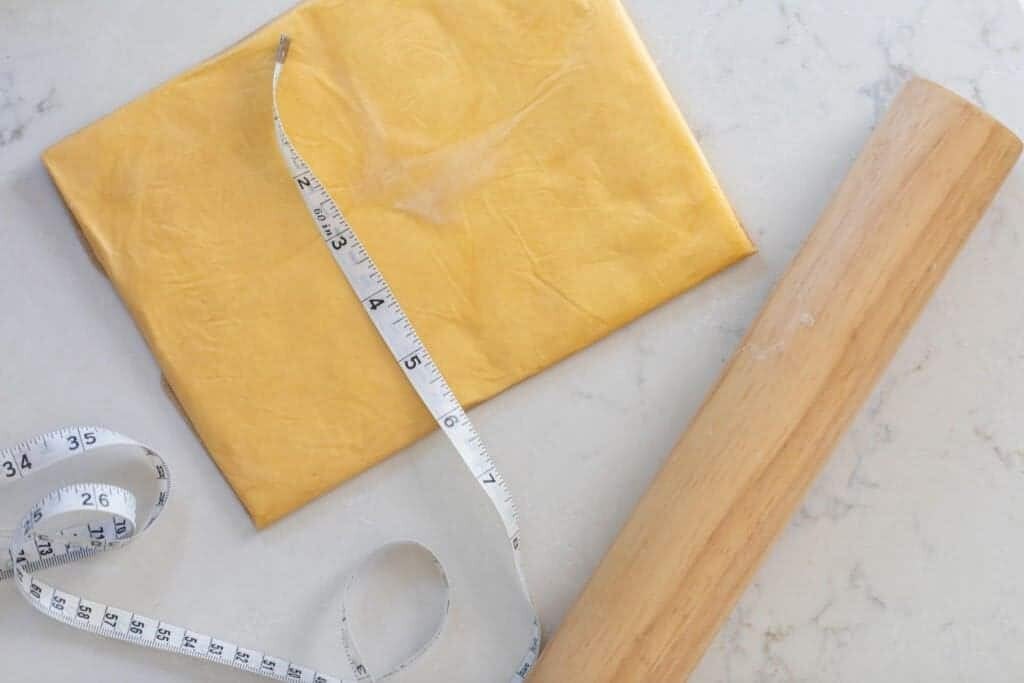
With a rolling pin, tap out the butter lightly to start to spread the butter, then roll smooth.
Chill the butter in the refrigerator for 10 minutes. You want the butter to stay nice and cold to create the layers of butter. If the butter gets too warm, it will just melt into the dough.
Remove the pastry dough from the refrigerator and place on a lightly floured surface.
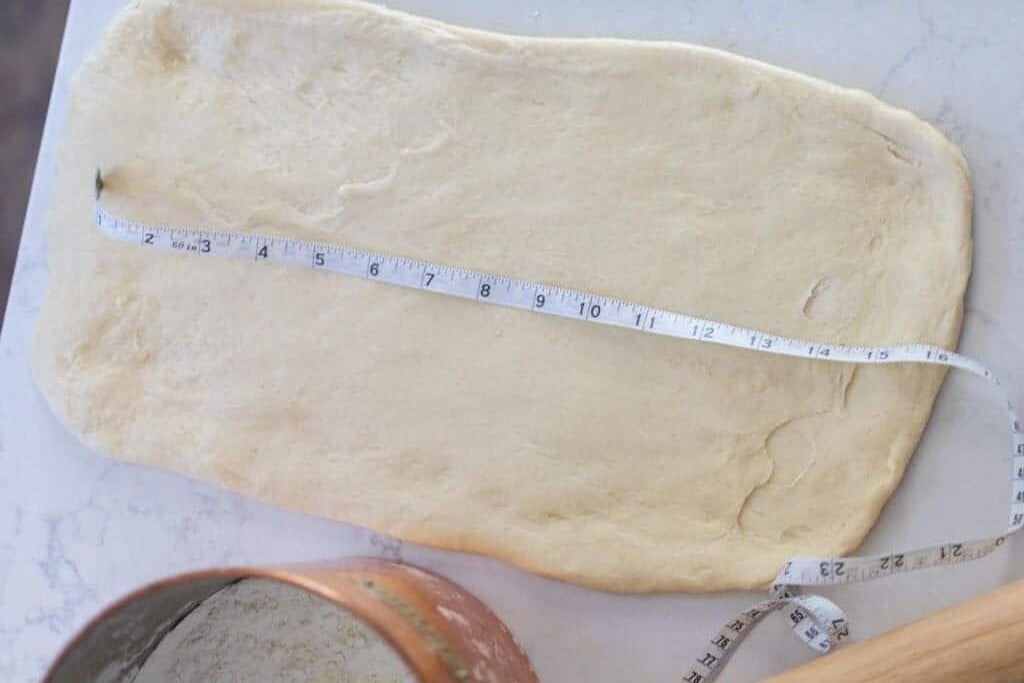
Roll it out into a 16″ by 8″ inch rectangle.
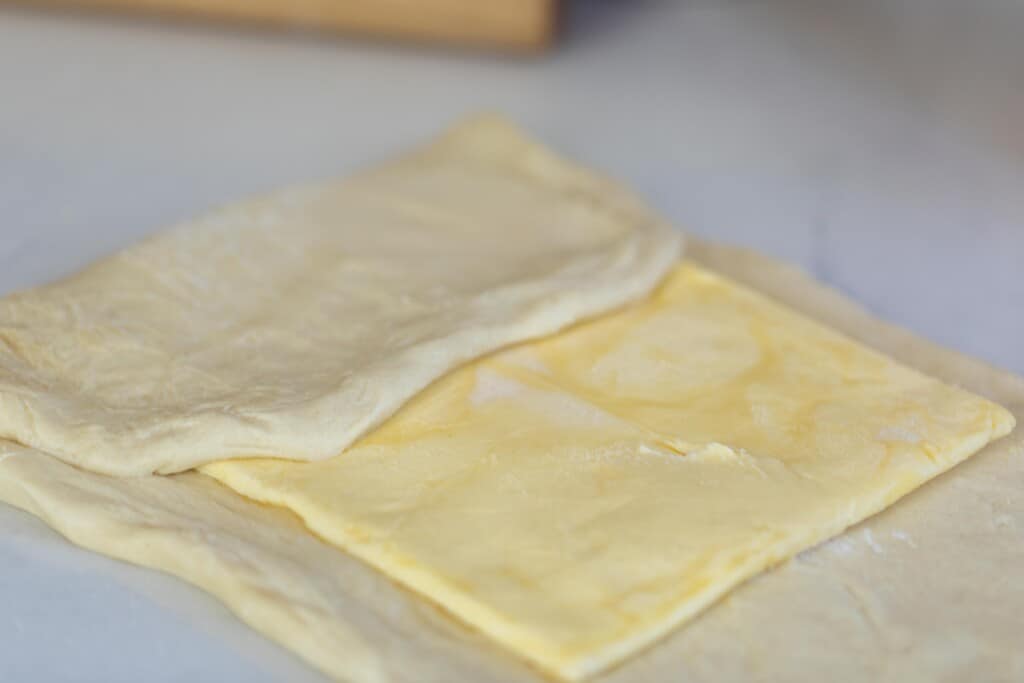
Place the butter rectangle in the middle of the dough. Fold the edges over, so they meet in the middle and completely encasing the butter. Pinch the dough together down the middle seam and sides closed, so none of the butter can escape.
First fold
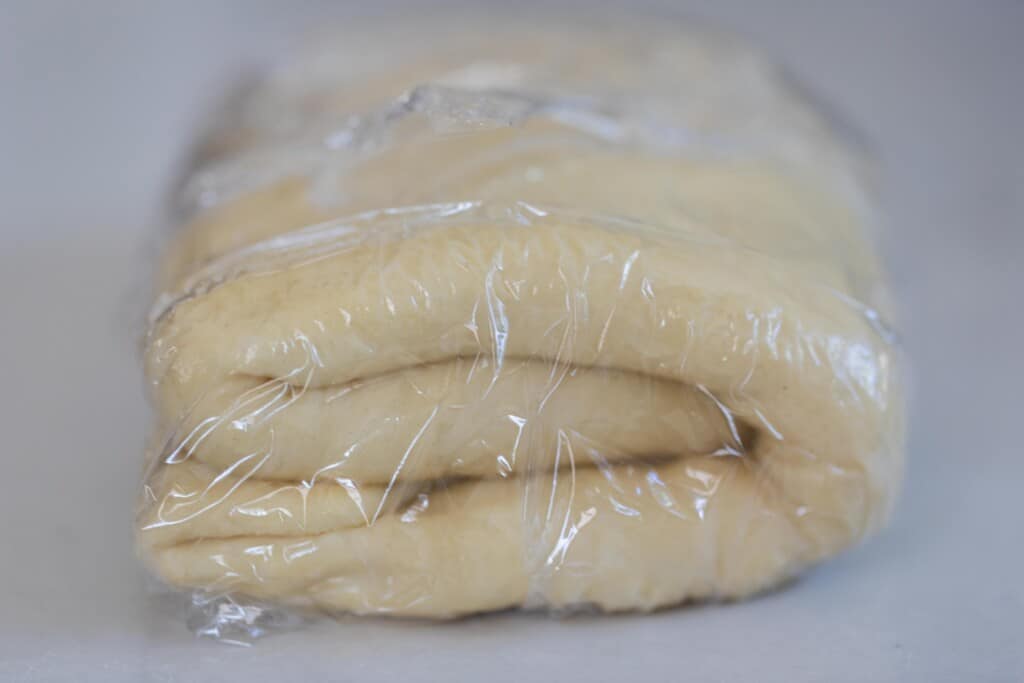
On a lightly floured work surface, roll the dough, with the butter sealed inside, into a 16″ by 8″ inch rectangle.
Fold each side into the center; then fold one side over the other to make a rectangle with four layers of folded dough. (See picture)
Wrap the dough in plastic wrap and place in the refrigerator for 30 minutes.
Second fold
Roll the dough out again into a 16″ by 8″ inch rectangle.
Fold each side into the center; then fold one side over the other to make a rectangle with 4 layers of dough.
Wrap the dough in plastic wrap and put it back in the refrigerator for 2 hours and up to 12 hours.
Use in any recipe calling for puff pastry.
What can you use sourdough puff pastry for?
- Turnovers
- Pop tarts
- Sweet pies – This makes a great sourdough pie crust recipe (although I have a recipe for that too. Find that here).
- Hand pies
- Savory pies like pot pies.
If you try this recipe and love it, I would love if you gave it 5 stars! Thank you! Tag me on Instagram @farmhouseonboone.
Sourdough Puff Pastry

Ingredients
Dough
- 3 cups all purpose flour, 420 grams
- 1/4 cup sugar, 50 grams
- 1/2 cup sourdough starter, bubbly and active (113 grams)
- 3/4 cup whole milk, 183 grams
- 1 large egg
- 1/2 teaspoon vanilla
- 1 teaspoon salt, 5 grams
Butter for laminating
- 16 tablespoons cold unsalted butter, 2 sticks or 227 grams
- 1 tablespoon all purpose flour, 9 grams
Egg wash:
- 1 large egg white, beaten lightly
- 1 tablespoon cold water
Instructions
- To a bowl of a stand mixer with a dough hook attachment, add the dry ingredients, sourdough starter, milk, egg, and vanilla.
- Mix on low speed (1 or 2) for about 5 or so minutes or until it becomes smooth and glossy. You can also knead this by hand. Mix and knead to make a shaggy, sticky dough then continue to knead for about 5-10 minutes until smooth and glossy.
- Shape into a ball and place in a greased large bowl. Cover with plastic wrap, foil, or a beeswax wrap and place at room temperature (a warm place) for about 4 hours.
- Transfer the bowl to the refrigerator to continue fermenting for 8 hours, or up to 3 days.
Laminating the dough
- Place the sticks of butter on a large piece of parchment paper. Sprinkle it with a little flour. Mark a 6″ by 8″ rectangle onto the parchment paper.
- Fold the parchment paper around the butter with the folds on that 6" by 8" rectangle you made, so that the butter will fill the entire envelope once you roll it out (also called a butter packet). It doesn’t need to be perfectly precise.
- With a rolling pin, tap out the butter lightly to start to spread the butter, then roll smooth.
- Chill the butter in the refrigerator for 10 minutes. You want the butter to stay nice and cold to create the layers of butter. If the butter gets too warm, it will just melt into the dough.
- Remove the pastry dough from the refrigerator and place on a lightly floured surface.
- Roll it out into a 16″ by 8″ inch rectangle.
- Place the butter rectangle in the middle of the dough. Fold the edges over, so they meet in the middle and completely encase the butter. Pinch the dough together down the middle seam and sides closed, so none of the butter can escape.
First fold
- On a lightly floured work surface, roll the dough, with the butter sealed inside, into a 16″ by 8″ inch rectangle.
- Fold each side into the center; then fold one side over the other to make a rectangle with four layers of folded dough.
- Wrap the dough in plastic wrap and place in the refrigerator for 30 minutes.
Second fold
- Roll the dough out again into a 16″ by 8″ inch rectangle.
- Fold each side into the center; then fold one side over the other to make a rectangle with 4 layers of dough.
- Wrap the dough in plastic wrap and put it back in the refrigerator for 2 hours or up to 12 hours.
- Use in any recipe calling for puff pastry.
Notes
- Be careful to not let the dough or the butter get too warm during lamination. You want to work fairly quickly ensuring both stay around the same temperature. Rather than creating butter layers, the butter will just melt into the dough. If either the dough or the butter does get too warm, stick it in the fridge for 10-30 minutes and then continue working on the dough.
- When baking puff pastry, place a baking sheet on a rack below the pan the pastry is baking. This is extra protection just in case butter leaked out during the baking proccess.
Nutrition
Nutrition information is automatically calculated, so should only be used as an approximation.















Could you please share the link where you showed how to make this on You Tube? I am trying to go back through all the videos I’ve watched (which i love so its alot!) and am having trouble finding it. I do much better watching someone do the instruction verses reading them- Thanks so very much!!!
I made a double batch a few weeks ago after scribbling the recipe down during your video. I thought for sure I had ruined both batches during the laminating step because my butter just seemed too hard. I put them in the fridge and prayed for a couple days before I got the nerve to try rolling it out again. Lo and behold, it was perfect and so delicious..praise God! I made cheese twists, plain and chocolate croissants, and cherry danishes. Thank you for sharing!!
Those all sound amazing! Glad it worked out for you and you stuck with it.
Is the dough supposed to rise when it sits on the counter for 4 hours?
Not very much, if any.
I love making your sourdough croissant recipe. I might replace it with this one on the regular though bcs it is so much easier to work with! Can’t wait to see how this bakes up. Thanks for sharing Lisa!
So glad you enjoy these recipes! thanks for sharing!
This came out so great, Lisa! I love it, and love how much it made! Such a fun and unexpected way to use my sourdough starter.
Yay! Glad you enjoyed this recipe.
Hi lisa, i am so exited to make this recipe. At what temp do you need to bake this?
I usually bake it at 400 degrees.
Hey Lisa I’m watching your most recent video and came to find the puff pastry recipe you used in your pot pie. For a savory application do you leave out the vanilla? What about the sugar? I imagine the vanilla is just for flavor but I’m not sure if the sugar is important in any way for the texture etc. Thanks for inspiring me to get back into sourdough!
You probably could. There isn’t a ton of sugar in the recipe so it can lend itself to sweet and savory applications
Hi, Lisa!
First, congratulations on baby Victor!
My question is _ Can this be frozen, thawed and then used?
Thank you!
I have never tried it to be sure.
I just made a batch and put it in the freezer. I’ll update if it turns out well! 🙂
Hi, Lisa, This is probably a stupid question, but I am trying to learn. I love your recipe and understand the directions; but if the butter is not at room temp, then how will I roll the hard sticks of butter? The dough would be pretty rough, wouldn’t it? I just don’t see how I can roll the dough smooth,
I tried another on-line puff pastry recipe and they wanted the butter to be room temp, but it was so soft, it was a complete mess, and it (the butter) was mostly left on my paper.
Like I said, I’m a beginner at this.
Do I leave the sticks whole or should I cube them? Thanks for your help!
Cathie
No worries at all! So you want the butter and dough to be about the same temperature. If it is too warm it will just turn into a mess. So using a rolling pin, you can pound it and roll it with a little muscle. So leave the sticks whole and then roll them out. Hope that helps.
I’ve invested in a lot of grains, including hard red and white wheat, soft wheat, Kamut grain and Kamut white. I’d like to know if any of these can be incorporated in your puff pastry recipe? I love your sourdough tutorials but it would be helpful if you could touch on how to replace all purpose with more milled grains. I’m a beginner and I’m experimenting with everything so it would be very helpful. Thank you so much! Patty
So exciting that you are starting to mill your own flour! I have not tried any of those in this specific recipe yet. I will keep in mind to do some more posts on working with freshly milled grains. Thanks!
I’ve been grinding my own grains for years and incorporate them into most of my baking recipes. For the most part it’s a 1:1 substitution but I always start a with a little less of fresh milled flour (10% or so) than AP flour that a recipe calls for and add more as needed. As you get baking with it more and more you’ll start to intuit what will and won’t work. But remember to have fun!
Side note – hard red & white & kamut I use mostly for breads, hard white I’d use for this because of the higher protein level, soft white is great for pancakes, waffles and cookies
I use the soft white wheat (that I mill as finely as possible) in this recipe with half all purpose white, it’s beautiful, flaky, rich and easily managed.